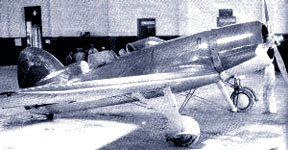|
By Chuck Acree  Bellanca 28-70 was a long-range racer designed for James Fitzmaurice of Ireland, who christened it Irish Swoop for the 1934 MacRobertson Race from England to Australia. The ship arrived in Great Britain barely in time for the race, but Fitzmaurice withdrew when the rules committee limited his fuel load because of incomplete testing of the new aircraft. The 28-70 went back to the USA to finish its tests, but was badly damaged in a landing accident. In 1936 the aircraft was rebuilt with a 900hp P&W Twin Wasp and redesignated 28-90. It was also renamed Dorothy and used by James Mollison for a new transatlantic speed record. In 1937 Mollison flew to Madrid and sold the plane to a Republican government desperate for any modern aircraft to use in their civil war. Legend has it that Dorothy was lost in combat during a reconnaissance mission, although historians are not sure what happened. Spanish Republicans had been impressed with the fast, long-range Bellanca even before the arrival of Dorothy. Late in 1936 they contracted with Bellanca for 20 28-90Bs for delivery in 1937. Because of then-current US law prohibiting the sale of arms to nations at war, the true buyer had to be hidden, and it was announced that they were for Air France as long-range mail carriers—the ruse went so far as to have Air France insignia and titles painted on the ships. However, when the order was completed, export permission was denied. Yet a Chinese Purchasing Commission bought the aircraft for use in their war and the US government had no objection to that! The 20 aircraft arrived in Hangkow later in 1937, where bomb racks were fitted, but most were destroyed by Japanese bombs before getting airborne. One more order came for the 28-90Bs (which Bellanca had meanwhile named Flash), 22 planes for a Greek aviation school, but that export was again denied because the aircraft were actually headed for Spain again! The planes were eventually shipped to Mexico after an American exporter received permission to sell them to the Mexican government. Of course, the real intent was to send them to Spain, but before the planes could be loaded on a boat, the Spanish civil war was over and the Republican government defeated. For a year the crated Bellancas languished in a Veracruz warehouse during negotiations about their disposition. There are several versions of how those negotiations went, but the planes finally went to Fuerza Aerea Mexicana (FAM) for assembly either in the fall of 1939 or the spring of 1940 (depending on which version of the story is true). The 28-90Bs were with the FAM First Regiment at Balbuena for only a short time. One account tells of four mishaps with the Bellancas, all caused by errors of the inexperienced pilots. In reality, at least two accidents occurred—the first caused by engine failure on landing approach near Lake Texcoco, and the second when Capitán Enrique Ochoa confused the flap and landing gear levers during approach on 8/22/40, with fatal results. Shortly after, the Bellancas were grounded. The planes might have been placed in storage or used as instructional airframes for student mechanics. In either case, they were bought in 1946 by Babbco Inc, the Mexican affiliate of Charles E Babb Company, who tried to sell the by then very obsolete aircraft to the USN for use as trainers. Thus ended the very curious tale of the Bellanca Flash. — Source: Latin American Aviation Historical Society (LAAHS.com) Fate of the 20 or so Babb planes is unknown. Some reports have most of them going to various South American countries. Documented information is most welcome. (-- K O Eckland)
|